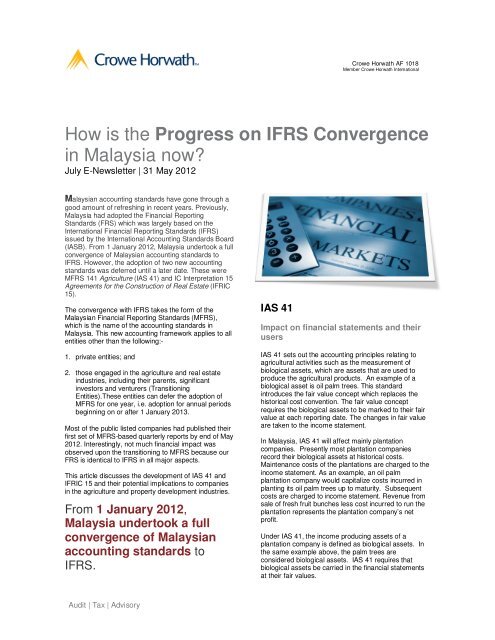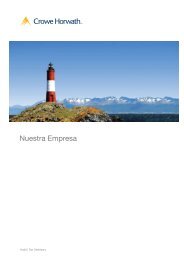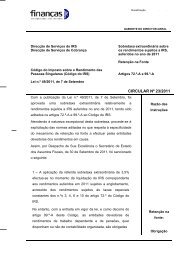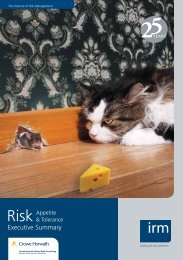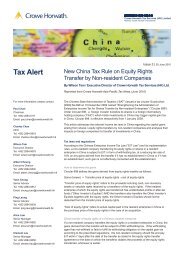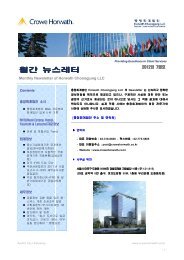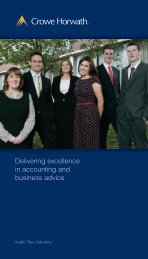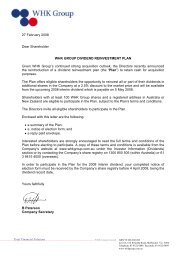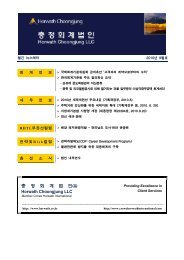How is the Progress on IFRS Convergence in Malaysia now?
How is the Progress on IFRS Convergence in Malaysia now?
How is the Progress on IFRS Convergence in Malaysia now?
Create successful ePaper yourself
Turn your PDF publications into a flip-book with our unique Google optimized e-Paper software.
Crowe Horwath AF 1018<br />
Member Crowe Horwath Internati<strong>on</strong>al<br />
<str<strong>on</strong>g>How</str<strong>on</strong>g> <str<strong>on</strong>g>is</str<strong>on</strong>g> <str<strong>on</strong>g>the</str<strong>on</strong>g> <str<strong>on</strong>g>Progress</str<strong>on</strong>g> <strong>on</strong> <strong>IFRS</strong> C<strong>on</strong>vergence<br />
<strong>in</strong> <strong>Malaysia</strong> <strong>now</strong>?<br />
July E-Newsletter | 31 May 2012<br />
<strong>Malaysia</strong>n account<strong>in</strong>g standards have g<strong>on</strong>e through a<br />
good amount of refresh<strong>in</strong>g <strong>in</strong> recent years. Previously,<br />
<strong>Malaysia</strong> had adopted <str<strong>on</strong>g>the</str<strong>on</strong>g> F<strong>in</strong>ancial Report<strong>in</strong>g<br />
Standards (FRS) which was largely based <strong>on</strong> <str<strong>on</strong>g>the</str<strong>on</strong>g><br />
Internati<strong>on</strong>al F<strong>in</strong>ancial Report<strong>in</strong>g Standards (<strong>IFRS</strong>)<br />
<str<strong>on</strong>g>is</str<strong>on</strong>g>sued by <str<strong>on</strong>g>the</str<strong>on</strong>g> Internati<strong>on</strong>al Account<strong>in</strong>g Standards Board<br />
(IASB). From 1 January 2012, <strong>Malaysia</strong> undertook a full<br />
c<strong>on</strong>vergence of <strong>Malaysia</strong>n account<strong>in</strong>g standards to<br />
<strong>IFRS</strong>. <str<strong>on</strong>g>How</str<strong>on</strong>g>ever, <str<strong>on</strong>g>the</str<strong>on</strong>g> adopti<strong>on</strong> of two new account<strong>in</strong>g<br />
standards was deferred until a later date. These were<br />
MFRS 141 Agriculture (IAS 41) and IC Interpretati<strong>on</strong> 15<br />
Agreements for <str<strong>on</strong>g>the</str<strong>on</strong>g> C<strong>on</strong>structi<strong>on</strong> of Real Estate (IFRIC<br />
15).<br />
The c<strong>on</strong>vergence with <strong>IFRS</strong> takes <str<strong>on</strong>g>the</str<strong>on</strong>g> form of <str<strong>on</strong>g>the</str<strong>on</strong>g><br />
<strong>Malaysia</strong>n F<strong>in</strong>ancial Report<strong>in</strong>g Standards (MFRS),<br />
which <str<strong>on</strong>g>is</str<strong>on</strong>g> <str<strong>on</strong>g>the</str<strong>on</strong>g> name of <str<strong>on</strong>g>the</str<strong>on</strong>g> account<strong>in</strong>g standards <strong>in</strong><br />
<strong>Malaysia</strong>. Th<str<strong>on</strong>g>is</str<strong>on</strong>g> new account<strong>in</strong>g framework applies to all<br />
entities o<str<strong>on</strong>g>the</str<strong>on</strong>g>r than <str<strong>on</strong>g>the</str<strong>on</strong>g> follow<strong>in</strong>g:-<br />
1. private entities; and<br />
2. those engaged <strong>in</strong> <str<strong>on</strong>g>the</str<strong>on</strong>g> agriculture and real estate<br />
<strong>in</strong>dustries, <strong>in</strong>clud<strong>in</strong>g <str<strong>on</strong>g>the</str<strong>on</strong>g>ir parents, significant<br />
<strong>in</strong>vestors and venturers (Transiti<strong>on</strong><strong>in</strong>g<br />
Entities).These entities can defer <str<strong>on</strong>g>the</str<strong>on</strong>g> adopti<strong>on</strong> of<br />
MFRS for <strong>on</strong>e year, i.e. adopti<strong>on</strong> for annual periods<br />
beg<strong>in</strong>n<strong>in</strong>g <strong>on</strong> or after 1 January 2013.<br />
Most of <str<strong>on</strong>g>the</str<strong>on</strong>g> public l<str<strong>on</strong>g>is</str<strong>on</strong>g>ted companies had publ<str<strong>on</strong>g>is</str<strong>on</strong>g>hed <str<strong>on</strong>g>the</str<strong>on</strong>g>ir<br />
first set of MFRS-based quarterly reports by end of May<br />
2012. Interest<strong>in</strong>gly, not much f<strong>in</strong>ancial impact was<br />
observed up<strong>on</strong> <str<strong>on</strong>g>the</str<strong>on</strong>g> transiti<strong>on</strong><strong>in</strong>g to MFRS because our<br />
FRS <str<strong>on</strong>g>is</str<strong>on</strong>g> identical to <strong>IFRS</strong> <strong>in</strong> all major aspects.<br />
Th<str<strong>on</strong>g>is</str<strong>on</strong>g> article d<str<strong>on</strong>g>is</str<strong>on</strong>g>cusses <str<strong>on</strong>g>the</str<strong>on</strong>g> development of IAS 41 and<br />
IFRIC 15 and <str<strong>on</strong>g>the</str<strong>on</strong>g>ir potential implicati<strong>on</strong>s to companies<br />
<strong>in</strong> <str<strong>on</strong>g>the</str<strong>on</strong>g> agriculture and property development <strong>in</strong>dustries.<br />
From 1 January 2012,<br />
<strong>Malaysia</strong> undertook a full<br />
c<strong>on</strong>vergence of <strong>Malaysia</strong>n<br />
account<strong>in</strong>g standards to<br />
<strong>IFRS</strong>.<br />
IAS 41<br />
Impact <strong>on</strong> f<strong>in</strong>ancial statements and <str<strong>on</strong>g>the</str<strong>on</strong>g>ir<br />
users<br />
IAS 41 sets out <str<strong>on</strong>g>the</str<strong>on</strong>g> account<strong>in</strong>g pr<strong>in</strong>ciples relat<strong>in</strong>g to<br />
agricultural activities such as <str<strong>on</strong>g>the</str<strong>on</strong>g> measurement of<br />
biological assets, which are assets that are used to<br />
produce <str<strong>on</strong>g>the</str<strong>on</strong>g> agricultural products. An example of a<br />
biological asset <str<strong>on</strong>g>is</str<strong>on</strong>g> oil palm trees. Th<str<strong>on</strong>g>is</str<strong>on</strong>g> standard<br />
<strong>in</strong>troduces <str<strong>on</strong>g>the</str<strong>on</strong>g> fair value c<strong>on</strong>cept which replaces <str<strong>on</strong>g>the</str<strong>on</strong>g><br />
h<str<strong>on</strong>g>is</str<strong>on</strong>g>torical cost c<strong>on</strong>venti<strong>on</strong>. The fair value c<strong>on</strong>cept<br />
requires <str<strong>on</strong>g>the</str<strong>on</strong>g> biological assets to be marked to <str<strong>on</strong>g>the</str<strong>on</strong>g>ir fair<br />
value at each report<strong>in</strong>g date. The changes <strong>in</strong> fair value<br />
are taken to <str<strong>on</strong>g>the</str<strong>on</strong>g> <strong>in</strong>come statement.<br />
In <strong>Malaysia</strong>, IAS 41 will affect ma<strong>in</strong>ly plantati<strong>on</strong><br />
companies. Presently most plantati<strong>on</strong> companies<br />
record <str<strong>on</strong>g>the</str<strong>on</strong>g>ir biological assets at h<str<strong>on</strong>g>is</str<strong>on</strong>g>torical costs.<br />
Ma<strong>in</strong>tenance costs of <str<strong>on</strong>g>the</str<strong>on</strong>g> plantati<strong>on</strong>s are charged to <str<strong>on</strong>g>the</str<strong>on</strong>g><br />
<strong>in</strong>come statement. As an example, an oil palm<br />
plantati<strong>on</strong> company would capitalize costs <strong>in</strong>curred <strong>in</strong><br />
plant<strong>in</strong>g its oil palm trees up to maturity. Subsequent<br />
costs are charged to <strong>in</strong>come statement. Revenue from<br />
sale of fresh fruit bunches less cost <strong>in</strong>curred to run <str<strong>on</strong>g>the</str<strong>on</strong>g><br />
plantati<strong>on</strong> represents <str<strong>on</strong>g>the</str<strong>on</strong>g> plantati<strong>on</strong> company’s net<br />
profit.<br />
Under IAS 41, <str<strong>on</strong>g>the</str<strong>on</strong>g> <strong>in</strong>come produc<strong>in</strong>g assets of a<br />
plantati<strong>on</strong> company <str<strong>on</strong>g>is</str<strong>on</strong>g> def<strong>in</strong>ed as biological assets. In<br />
<str<strong>on</strong>g>the</str<strong>on</strong>g> same example above, <str<strong>on</strong>g>the</str<strong>on</strong>g> palm trees are<br />
c<strong>on</strong>sidered biological assets. IAS 41 requires that<br />
biological assets be carried <strong>in</strong> <str<strong>on</strong>g>the</str<strong>on</strong>g> f<strong>in</strong>ancial statements<br />
at <str<strong>on</strong>g>the</str<strong>on</strong>g>ir fair values.<br />
Audit | Tax | Adv<str<strong>on</strong>g>is</str<strong>on</strong>g>ory
Crowe Horwath AF 1018<br />
Member Crowe Horwath Internati<strong>on</strong>al<br />
As a result, <str<strong>on</strong>g>the</str<strong>on</strong>g>re would be two factors affect<strong>in</strong>g <str<strong>on</strong>g>the</str<strong>on</strong>g><br />
results of a plantati<strong>on</strong> company. Firstly, <str<strong>on</strong>g>the</str<strong>on</strong>g><br />
operati<strong>on</strong>al results from <str<strong>on</strong>g>the</str<strong>on</strong>g> runn<strong>in</strong>g of <str<strong>on</strong>g>the</str<strong>on</strong>g><br />
plantati<strong>on</strong>. Sec<strong>on</strong>dly, <str<strong>on</strong>g>the</str<strong>on</strong>g> fair value changes of<br />
<str<strong>on</strong>g>the</str<strong>on</strong>g> biological assets.<br />
The Real Estate Industry<br />
Impact <strong>on</strong> <str<strong>on</strong>g>the</str<strong>on</strong>g> f<strong>in</strong>ancial statements and<br />
<str<strong>on</strong>g>the</str<strong>on</strong>g>ir users<br />
In <str<strong>on</strong>g>the</str<strong>on</strong>g> past, property developers recognized profits<br />
progressively. Th<str<strong>on</strong>g>is</str<strong>on</strong>g> has been accepted as reflective of<br />
<str<strong>on</strong>g>the</str<strong>on</strong>g> progress of work that <str<strong>on</strong>g>is</str<strong>on</strong>g> be<strong>in</strong>g carried out.<br />
IFRIC 15 requires property developers to account for<br />
profits <strong>on</strong>ly when a project <str<strong>on</strong>g>is</str<strong>on</strong>g> completed, if <str<strong>on</strong>g>the</str<strong>on</strong>g><br />
properties are homogeneous. Excepti<strong>on</strong> allowed by<br />
IFRIC 15 applies <strong>on</strong>ly when <str<strong>on</strong>g>the</str<strong>on</strong>g> properties are<br />
customized, for example, properties which <str<strong>on</strong>g>the</str<strong>on</strong>g> buyers<br />
dictate <str<strong>on</strong>g>the</str<strong>on</strong>g> design and materials to be used. As most<br />
properties developed <strong>in</strong> <strong>Malaysia</strong> are homogeneous,<br />
IFRIC 15 will affect most if not all developers.<br />
The <str<strong>on</strong>g>is</str<strong>on</strong>g>sues which we foresee from <str<strong>on</strong>g>the</str<strong>on</strong>g> implementati<strong>on</strong><br />
of IAS 41 are as follows:-<br />
1. The fair value changes <strong>in</strong> <str<strong>on</strong>g>the</str<strong>on</strong>g> biological assets do<br />
not have any cash flow impact as it <str<strong>on</strong>g>is</str<strong>on</strong>g> merely an<br />
account<strong>in</strong>g adjustment to report <str<strong>on</strong>g>the</str<strong>on</strong>g> biological<br />
assets at <str<strong>on</strong>g>the</str<strong>on</strong>g>ir fair values. As a result, it rema<strong>in</strong>s to<br />
be seen whe<str<strong>on</strong>g>the</str<strong>on</strong>g>r f<strong>in</strong>ancial statements users, such<br />
as analysts, will take <str<strong>on</strong>g>the</str<strong>on</strong>g> fair value changes <strong>in</strong><br />
assess<strong>in</strong>g <str<strong>on</strong>g>the</str<strong>on</strong>g> value of plantati<strong>on</strong> companies;<br />
The th<strong>in</strong>k<strong>in</strong>g beh<strong>in</strong>d IFRIC 15 <str<strong>on</strong>g>is</str<strong>on</strong>g> that <strong>in</strong> <str<strong>on</strong>g>the</str<strong>on</strong>g> case of<br />
homogeneous properties, <str<strong>on</strong>g>the</str<strong>on</strong>g> developer <str<strong>on</strong>g>is</str<strong>on</strong>g> sell<strong>in</strong>g a<br />
product as opposed to provid<strong>in</strong>g a service. Hence,<br />
profit can <strong>on</strong>ly be recognized up<strong>on</strong> <str<strong>on</strong>g>the</str<strong>on</strong>g> transfer of r<str<strong>on</strong>g>is</str<strong>on</strong>g>ks<br />
and rewards to <str<strong>on</strong>g>the</str<strong>on</strong>g> customers i.e. up<strong>on</strong> completi<strong>on</strong> and<br />
handover of <str<strong>on</strong>g>the</str<strong>on</strong>g> properties. Th<str<strong>on</strong>g>is</str<strong>on</strong>g> <str<strong>on</strong>g>is</str<strong>on</strong>g> a departure from our<br />
present practice of recogniz<strong>in</strong>g profit as c<strong>on</strong>structi<strong>on</strong><br />
progresses.<br />
2. The results may not reflect <str<strong>on</strong>g>the</str<strong>on</strong>g> profitability of <str<strong>on</strong>g>the</str<strong>on</strong>g><br />
plantati<strong>on</strong> companies’ operati<strong>on</strong>s. In extreme<br />
cases, where prices of commodities are volatile,<br />
such account<strong>in</strong>g treatment may mask an<br />
unprofitable operati<strong>on</strong>; and<br />
3. The costs of valuati<strong>on</strong>.<br />
Status of implementati<strong>on</strong><br />
The <strong>Malaysia</strong>n Account<strong>in</strong>g Standards Board (MASB),<br />
<str<strong>on</strong>g>the</str<strong>on</strong>g> account<strong>in</strong>g standards sett<strong>in</strong>g body <strong>in</strong> <strong>Malaysia</strong>,<br />
believes <str<strong>on</strong>g>the</str<strong>on</strong>g> ex<str<strong>on</strong>g>is</str<strong>on</strong>g>t<strong>in</strong>g IAS 41 <str<strong>on</strong>g>is</str<strong>on</strong>g> outdated. It <str<strong>on</strong>g>is</str<strong>on</strong>g> not<br />
surpr<str<strong>on</strong>g>is</str<strong>on</strong>g><strong>in</strong>g as s<strong>in</strong>ce 2008, MASB toge<str<strong>on</strong>g>the</str<strong>on</strong>g>r with several<br />
o<str<strong>on</strong>g>the</str<strong>on</strong>g>r standard setters have been <strong>in</strong> d<str<strong>on</strong>g>is</str<strong>on</strong>g>cussi<strong>on</strong> with <str<strong>on</strong>g>the</str<strong>on</strong>g><br />
IASB to rev<str<strong>on</strong>g>is</str<strong>on</strong>g>e IAS 41. Th<str<strong>on</strong>g>is</str<strong>on</strong>g> proposal had been added<br />
to <str<strong>on</strong>g>the</str<strong>on</strong>g> 2011 IASB project agenda. It <str<strong>on</strong>g>is</str<strong>on</strong>g> because of th<str<strong>on</strong>g>is</str<strong>on</strong>g><br />
that MASB has provided <str<strong>on</strong>g>the</str<strong>on</strong>g> <strong>on</strong>e year transiti<strong>on</strong> period<br />
to implement IAS 41.<br />
<str<strong>on</strong>g>How</str<strong>on</strong>g>ever, it <str<strong>on</strong>g>is</str<strong>on</strong>g> still uncerta<strong>in</strong> whe<str<strong>on</strong>g>the</str<strong>on</strong>g>r all <str<strong>on</strong>g>the</str<strong>on</strong>g> proposals <strong>in</strong><br />
<str<strong>on</strong>g>the</str<strong>on</strong>g> 2011 IASB project agenda will be accepted.<br />
Obviously, th<str<strong>on</strong>g>is</str<strong>on</strong>g> uncerta<strong>in</strong>ty <str<strong>on</strong>g>is</str<strong>on</strong>g> not ideal for <str<strong>on</strong>g>the</str<strong>on</strong>g><br />
agricultural <strong>in</strong>dustry players.<br />
In our view, th<str<strong>on</strong>g>is</str<strong>on</strong>g> change <strong>in</strong> <str<strong>on</strong>g>the</str<strong>on</strong>g> fundamental account<strong>in</strong>g<br />
c<strong>on</strong>cept may not be completed by end 2012. It may<br />
take a l<strong>on</strong>ger time for IASB to re-v<str<strong>on</strong>g>is</str<strong>on</strong>g>it IAS 41. In <str<strong>on</strong>g>the</str<strong>on</strong>g><br />
meantime, <str<strong>on</strong>g>the</str<strong>on</strong>g> jury <str<strong>on</strong>g>is</str<strong>on</strong>g> still out <str<strong>on</strong>g>the</str<strong>on</strong>g>re as to whe<str<strong>on</strong>g>the</str<strong>on</strong>g>r MASB<br />
will defer <str<strong>on</strong>g>the</str<strong>on</strong>g> adopti<strong>on</strong> of IAS 41 for ano<str<strong>on</strong>g>the</str<strong>on</strong>g>r year.<br />
IFRIC 15 requires property<br />
developers to account for<br />
profits <strong>on</strong>ly when a project <str<strong>on</strong>g>is</str<strong>on</strong>g><br />
completed, if <str<strong>on</strong>g>the</str<strong>on</strong>g> properties<br />
are homogeneous.<br />
Audit | Tax | Adv<str<strong>on</strong>g>is</str<strong>on</strong>g>ory<br />
© 2012 Crowe Horwath AF1018<br />
www.crowehorwath.com.my<br />
2
Crowe Horwath AF 1018<br />
Member Crowe Horwath Internati<strong>on</strong>al<br />
The implicati<strong>on</strong>s of IFRIC 15 are significant to <str<strong>on</strong>g>the</str<strong>on</strong>g><br />
property <strong>in</strong>dustry and can be summarized as follows:-<br />
1. Volatility <strong>in</strong> earn<strong>in</strong>gs – as profit <str<strong>on</strong>g>is</str<strong>on</strong>g> recognized <strong>on</strong>ly<br />
up<strong>on</strong> completi<strong>on</strong> of projects which can span 3<br />
years, <str<strong>on</strong>g>the</str<strong>on</strong>g>re will be report<strong>in</strong>g periods when a<br />
property developer does not report any profit. On<br />
<str<strong>on</strong>g>the</str<strong>on</strong>g> o<str<strong>on</strong>g>the</str<strong>on</strong>g>r hand, it will report bumper profit <strong>in</strong> <str<strong>on</strong>g>the</str<strong>on</strong>g><br />
year <str<strong>on</strong>g>the</str<strong>on</strong>g> project <str<strong>on</strong>g>is</str<strong>on</strong>g> completed;<br />
… <str<strong>on</strong>g>the</str<strong>on</strong>g> IFRIC Committee felt<br />
that <str<strong>on</strong>g>the</str<strong>on</strong>g> property developers<br />
<strong>in</strong> <strong>Malaysia</strong> have<br />
‘c<strong>on</strong>t<strong>in</strong>uously’ transferred<br />
<str<strong>on</strong>g>the</str<strong>on</strong>g> r<str<strong>on</strong>g>is</str<strong>on</strong>g>ks and rewards of <str<strong>on</strong>g>the</str<strong>on</strong>g><br />
2. Valuati<strong>on</strong> of property counter – th<str<strong>on</strong>g>is</str<strong>on</strong>g> will be made<br />
more difficult and subjective, as results cannot be<br />
used as a bas<str<strong>on</strong>g>is</str<strong>on</strong>g> to value property companies.<br />
Adjustments may need to be made to f<strong>in</strong>ancial<br />
numbers and questi<strong>on</strong>s will be ra<str<strong>on</strong>g>is</str<strong>on</strong>g>ed as to <str<strong>on</strong>g>the</str<strong>on</strong>g><br />
reliability of such adjustments; and<br />
3. Tax treatment – we understand that <str<strong>on</strong>g>the</str<strong>on</strong>g> tax<br />
authorities will c<strong>on</strong>t<strong>in</strong>ue to compute tax us<strong>in</strong>g <str<strong>on</strong>g>the</str<strong>on</strong>g><br />
previous account<strong>in</strong>g treatment where profit <str<strong>on</strong>g>is</str<strong>on</strong>g><br />
recognized progressively. Th<str<strong>on</strong>g>is</str<strong>on</strong>g> will give r<str<strong>on</strong>g>is</str<strong>on</strong>g>e to a<br />
property developer prepar<strong>in</strong>g a sec<strong>on</strong>d set of<br />
accounts to compute tax, <str<strong>on</strong>g>the</str<strong>on</strong>g>reby <strong>in</strong>curr<strong>in</strong>g<br />
additi<strong>on</strong>al costs.<br />
Status of implementati<strong>on</strong><br />
Given <str<strong>on</strong>g>the</str<strong>on</strong>g> significant impact to <str<strong>on</strong>g>the</str<strong>on</strong>g> property <strong>in</strong>dustry,<br />
MASB has approached <str<strong>on</strong>g>the</str<strong>on</strong>g> Internati<strong>on</strong>al F<strong>in</strong>ancial<br />
Report<strong>in</strong>g Interpretati<strong>on</strong>s Committee (IFRIC<br />
Committee) to d<str<strong>on</strong>g>is</str<strong>on</strong>g>cuss th<str<strong>on</strong>g>is</str<strong>on</strong>g> IFRIC. In November 2011,<br />
<str<strong>on</strong>g>the</str<strong>on</strong>g> IFRIC Committee reviewed <str<strong>on</strong>g>the</str<strong>on</strong>g> implicati<strong>on</strong>s of<br />
IFRIC 15 <strong>in</strong> <strong>Malaysia</strong>.<br />
The silver l<strong>in</strong><strong>in</strong>g from th<str<strong>on</strong>g>is</str<strong>on</strong>g> review <str<strong>on</strong>g>is</str<strong>on</strong>g> that our property<br />
developers may be able to recogn<str<strong>on</strong>g>is</str<strong>on</strong>g>e profit <strong>on</strong> a<br />
progressive bas<str<strong>on</strong>g>is</str<strong>on</strong>g>. Th<str<strong>on</strong>g>is</str<strong>on</strong>g> <str<strong>on</strong>g>is</str<strong>on</strong>g> because <str<strong>on</strong>g>the</str<strong>on</strong>g> IFRIC<br />
Committee felt that <str<strong>on</strong>g>the</str<strong>on</strong>g> property developers <strong>in</strong> <strong>Malaysia</strong><br />
have ‘c<strong>on</strong>t<strong>in</strong>uously’ transferred <str<strong>on</strong>g>the</str<strong>on</strong>g> r<str<strong>on</strong>g>is</str<strong>on</strong>g>ks and rewards of<br />
<str<strong>on</strong>g>the</str<strong>on</strong>g> properties’ ownership to <str<strong>on</strong>g>the</str<strong>on</strong>g>ir customers while <str<strong>on</strong>g>the</str<strong>on</strong>g><br />
developments are <strong>in</strong> progress.<br />
properties’ ownership to <str<strong>on</strong>g>the</str<strong>on</strong>g>ir<br />
customers while <str<strong>on</strong>g>the</str<strong>on</strong>g><br />
developments are <strong>in</strong> progress.<br />
In <str<strong>on</strong>g>the</str<strong>on</strong>g> same m<strong>on</strong>th, IASB <str<strong>on</strong>g>is</str<strong>on</strong>g>sued exposure draft for IAS<br />
18 Revenue for public comment which br<strong>in</strong>gs <strong>in</strong> a new<br />
recogniti<strong>on</strong> c<strong>on</strong>cept <strong>on</strong> revenue that may replace IFRIC<br />
15. IASB planned to f<strong>in</strong>al<str<strong>on</strong>g>is</str<strong>on</strong>g>e th<str<strong>on</strong>g>is</str<strong>on</strong>g> new IAS 18 by <str<strong>on</strong>g>the</str<strong>on</strong>g><br />
sec<strong>on</strong>d half of 2012.<br />
In view of <str<strong>on</strong>g>the</str<strong>on</strong>g> <str<strong>on</strong>g>the</str<strong>on</strong>g>se proposed changes to IAS 18 and<br />
IFRIC 15 and <str<strong>on</strong>g>the</str<strong>on</strong>g> significant implicati<strong>on</strong>s to <str<strong>on</strong>g>the</str<strong>on</strong>g> property<br />
<strong>in</strong>dustry, it <str<strong>on</strong>g>is</str<strong>on</strong>g> not surpr<str<strong>on</strong>g>is</str<strong>on</strong>g><strong>in</strong>g that MASB had decided <strong>on</strong><br />
a <strong>on</strong>e year transiti<strong>on</strong> period to implement IFRIC 15.<br />
Th<str<strong>on</strong>g>is</str<strong>on</strong>g> article <str<strong>on</strong>g>is</str<strong>on</strong>g> written by James Chan<br />
Audit Partner<br />
Audit | Tax | Adv<str<strong>on</strong>g>is</str<strong>on</strong>g>ory<br />
© 2012 Crowe Horwath AF1018<br />
www.crowehorwath.com.my<br />
3


